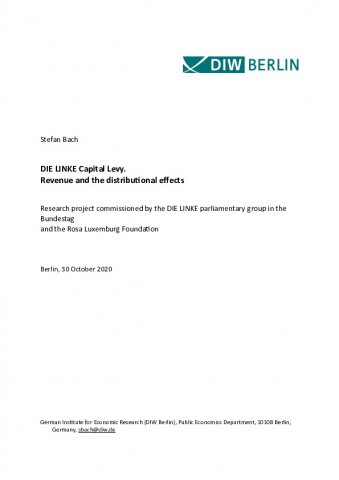DIE LINKE Capital Levy. Revenue and the distributional effects
A research project by DIW Berlin, commissioned by the DIE LINKE parliamentary group in the Bundestag and the Rosa Luxemburg Foundation
Summary
This study[1] examines the revenue and the distributional effects of the DIE LINKE proposal for a capital levy. The proposed levy would be a one-off charge on the existing net assets of private households. The revenue is intended to help finance the financial burdens on public budgets caused by the coronavirus economic crisis. The historical starting point is the capital levy under the equalisation of burdens (the "Lastenausgleich") of 1952.
The levy would be charged on assets subject to the levy as at 1 January 2020 and would be paid over a period of 20 years. The tax base consists of the individual net assets of each natural person, calculated from the assets subject to the levy, less the liabilities on those assets. A separate allowance of 2 or 5 million euros is planned for business assets. A personal allowance of 1 or 2 million euros is also to be deducted from the assets subject to the levy. The capital levy rate is progressive, starting at 10 percent and rising to 30 percent on higher wealth subject to the levy. The peak rate will start at assets subject to the levy of 30 million euros; alternatively, variants at 50 million euros and 100 million euros are considered. Either a tiered rate or a linear-progressive rate is to be applied, the latter placing a greater burden on levy-payers at the onset.
Our study is based on the third wave of the Household Finance and Consumption Survey (HFCS) by the Eurosystem central banks - the German survey was conducted by Deutsche Bundesbank in 2017. The 300 wealthiest Germans according to the list compiled by "manager magazin" (2017) are also integrated into the model dataset. Assuming a Pareto distribution, the wealth and wealth distribution of high net worth households (3 million euros or more) is estimated for the top range of wealth. Using a microsimulation model, we analyse revenue and the distributional effects, as well as the collection costs of the capital levy.
The concentration of wealth in Germany is considerable. The richest one percent of the population, which starts at a personal net assets of 1.8 million euros, owns 32 percent of all assets. The richest 0.1 percent, which starts at personal net assets of 8.7 million euros, owns 16 percent of all assets. A capital levy can therefore generate considerable revenue, even if the allowances are high.
The most levy revenue is generated when the top rate for the levy starts at assets of 30 million euros (Tabelle 01). Depending on the scenario for the tax base, the levy revenue for the tiered rate ranges from 338 billion euros (with a personal allowance of 2 million euros and an allowance for business assets of 5 million euros) to 501 billion euros (with a personal allowance of 1 million euros and no allowance for business assets). For a linear-progressive rate, the revenue is about 10 percent higher, ranging from 369 to 560 billion euros. The annual levy revenue in these scenarios is 20 to 35 billion euros.
Owing to the high concentration of wealth and the progressive levy rate, the levy revenue is highly concentrated in the top percentiles of wealth distribution. The richest 0.1 percent pay up to 80 percent of the levy revenue at a personal allowance of 1 million euros and up to 90 percent of the levy revenue at a personal allowance of 2 million euros. This means a moderate reduction in the high level of wealth inequality. Regarding collection costs, the capital levy is significantly cheaper than an ongoing wealth tax, as the tax base only has to be measured once. The costs are 2 to 3.5 percent of the revenue.
If the top levy rate of 30 percent only starts to apply at assets of 50 or 100 million euros, the levy revenue is lower. The revenue is then somewhat less concentrated in the wealthiest 0.1 percent of the population. The share of collection costs is minimally increased as a result of the lower revenue.
As the levy is to be charged on assets as at the start of 2020, levy-payers can no longer avoid it via structures. To this extent, there are no direct substitution effects - and therefore there is no excess burden - for the capital levy. However, the capital levy triggers wealth and income effects. This may mean liquidity and financing problems for real estate or business assets, in particular if the current return on assets is not sufficient to pay the ongoing capital levy.
Links:
- https://www.fabio-de-masi.de/kontext/controllers/document.php/479.e/a/e1197c.pdf
Downloads
-
 DIE LINKE Capital Levy. Revenue and the distributional effects
DIW Berlin / Stefan Bach
DIE LINKE Capital Levy. Revenue and the distributional effects
DIW Berlin / Stefan Bach